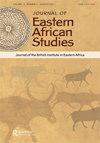‘Demonstration fields’, anticipation, and contestation: agrarian change and the political economy of development corridors in Eastern Africa
IF 0.6
3区 社会学
Q2 AREA STUDIES
引用次数: 23
Abstract
ABSTRACT In much of Eastern Africa, the last decade has seen a renewed interest in spatial development plans that link mineral exploitation, transport infrastructure and agricultural commercialisation. While these development corridors have yielded complex results – even in cases where significant investments are yet to happen – much of the existing analysis continues to focus on economic and implementation questions, where failures are attributed to inappropriate incentives or lack of ‘political will’. Taking a different – political economy – approach, this article examines what actually happens when corridors ‘hit the ground’, with a specific interest to the diverse agricultural commercialisation pathways that they induce. Specifically, the article introduces and analyses four corridors – LAPSSET in Kenya, Beira and Nacala in Mozambique, and SAGCOT in Tanzania – which are generating ‘demonstration fields’, economies of anticipation and fields of political contestations respectively, and as a result, creating – or promising to create – diverse pathways for agricultural commercialisation, accumulation and differentiation. In sum, the article shows how top-down grand-modernist plans are shaped by local dynamics, in a process that results in the transformation of corridors, from exclusivist ‘tunnel’ visions, to more networked corridors embedded in local economies, and shaped by the realities of rural Eastern Africa.“示范田”、预期和争论:东非发展走廊的土地变化和政治经济
摘要在过去的十年里,东非大部分地区对将矿产开采、交通基础设施和农业商业化联系起来的空间发展计划重新产生了兴趣。尽管这些发展走廊产生了复杂的结果——即使在尚未进行重大投资的情况下也是如此——但现有的大部分分析仍然集中在经济和实施问题上,这些问题的失败归因于不适当的激励措施或缺乏“政治意愿”。本文采用了一种不同的政治经济学方法,考察了当走廊“落地”时实际会发生什么,并对其引发的各种农业商业化途径特别感兴趣。具体而言,本文介绍并分析了四条走廊——肯尼亚的LAPSSET、莫桑比克的贝拉和纳卡拉以及坦桑尼亚的SAGCOT——它们分别产生了“示范场”、预期经济和政治竞争场,因此,创造或承诺创造多样化的农业商业化途径,积累和分化。总之,这篇文章展示了自上而下的大现代主义计划是如何由当地动态塑造的,在这个过程中,走廊从排他性的“隧道”愿景转变为嵌入当地经济的更网络化的走廊,并由东非农村的现实塑造。
本文章由计算机程序翻译,如有差异,请以英文原文为准。
求助全文
约1分钟内获得全文
求助全文
来源期刊

Journal of Eastern African Studies
AREA STUDIES-
CiteScore
3.30
自引率
7.10%
发文量
12
期刊介绍:
Journal of Eastern African Studies is an international publication of the British Institute in Eastern Africa, published four times each year. It aims to promote fresh scholarly enquiry on the region from within the humanities and the social sciences, and to encourage work that communicates across disciplinary boundaries. It seeks to foster inter-disciplinary analysis, strong comparative perspectives, and research employing the most significant theoretical or methodological approaches for the region.
 求助内容:
求助内容: 应助结果提醒方式:
应助结果提醒方式:


